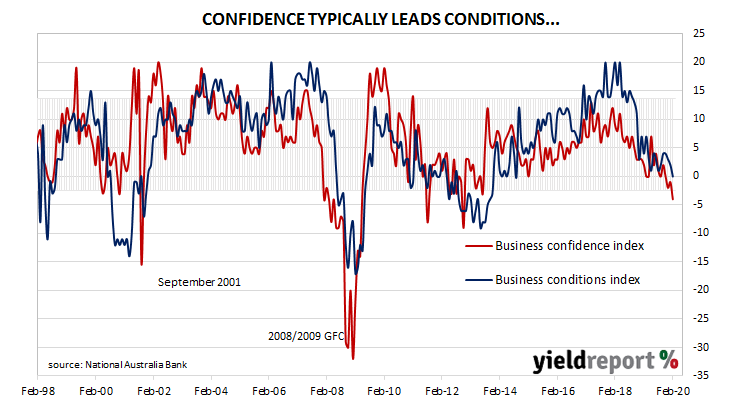Australian business conditions were robust in the first half of 2018 and a cyclical-peak was reached in April of that year. Readings then began to slip and, by the end of 2018, they had dropped to below-average levels. Forecasts of a slowdown in the domestic economy began to emerge in the first half of 2019 and while conditions remained quite stable at low-growth levels for a period, confidence readings began trending lower.
According to NAB’s latest monthly business survey of 400 firms conducted in the second half of February, business conditions continued to bump along at below-average levels. The NAB’s conditions index has registered 0, down from January’s revised reading of 2.
Business confidence continued its recent downward slide. NAB’s confidence index fell from -1 to -4, further below its long-term average reading of 6. Typically, NAB’s confidence index leads the conditions index by approximately one month, although some divergences appear from time to time.
Alan Oster, NAB’s chief economist, said the survey suggests “ongoing softness in the business sector with conditions and confidence having tracked below average for some time and capacity utilisation hovering around average in recent months.”
US Treasury bond yields had jumped significantly in overnight trading after expectations were raised of a large US fiscal package to cushion the US economy. Local yields largely followed and, by the end of the day, the 3-year ACGB yield had increased by 10bps to 0.48%, the 10-year yield had jumped by 18bps to 0.79% while the 20-year yield finished 20bps higher at 1.19%.
Prices of cash futures contracts moved to reflect a slight softening of rate-cut expectations but only in a technical sense. The April contract still implied a 25bps cut to be fully factored in, the same as at the end of the previous day’s trade. However, further rate cuts were seen as not particularly likely as the cash rate target would already be at what the RBA considers to be the effective lower bound of 0.25%.

